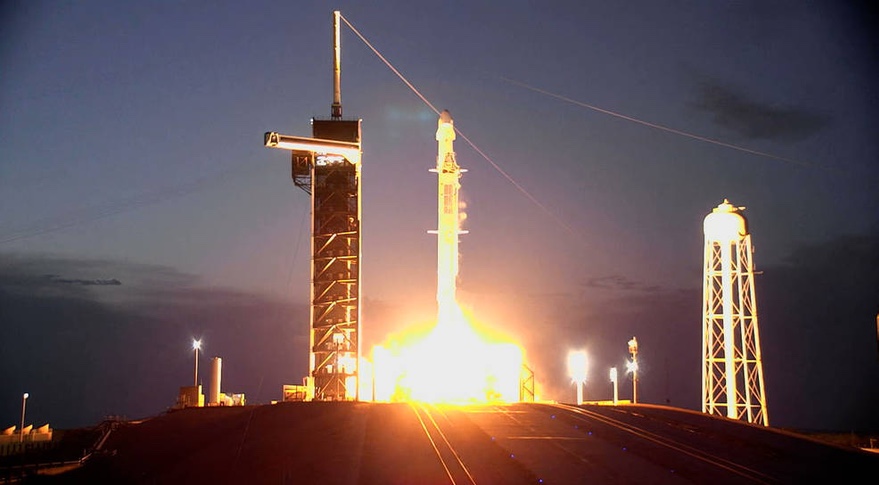WASHINGTON — A SpaceX cargo Dragon spacecraft is on its way to the International Space Station after a July 14 launch delayed more than a month by a hydrazine leak on the spacecraft.
A Falcon 9 lifted off from Kennedy Space Center’s Launch Complex 39A at 8:44 p.m. Eastern, deploying the Dragon into low Earth orbit 12 minutes later. The spacecraft is scheduled to dock with the station at about 11:20 a.m. Eastern July 16.
The Falcon 9 first stage landed on a droneship in the Atlantic Ocean seven and a half minutes after liftoff. The stage completed its fifth flight, having previously launched the Crew-3, Crew-4 and CRS-22 missions for NASA and the Turksat 5B communications satellite. The launch was the 30th so far this year for SpaceX, versus 31 for all of 2021.
The Dragon spacecraft, flying a mission designated CRS-25, is carrying 2,668 kilograms of cargo, including science investigations as well as crew supplies, spacewalk equipment and hardware. That total includes 544 kilograms of equipment located in the unpressurized trunk section of the spacecraft.
Among the science payloads is an Earth science instrument called the Earth Surface Mineral Dust Source Investigation, or EMIT, that will be installed on the station’s exterior. It will be used to study dust mineral dust in the atmosphere and how it interacts with ecosystems globally.
“We really need to be able to model how dust interacts with the full Earth system,” said Robert Green, principal investigator for EMIT at the Jet Propulsion Laboratory, during a NASA briefing in June. EMIT will provide far more data on mineral dust than other sensors. “We will use these new measurements to update those Earth system models and bring better fidelity to the Earth system models.” The instrument will also support planning for the Earth System Observatory line of future missions.
The CRS-25 mission had been scheduled to launch in early June. However, NASA and SpaceX postponed the launch after detecting what NASA called “elevated vapor readings” of hydrazine in the spacecraft’s propulsion system. Dragon uses monomethyl hydrazine and nitrogen tetroxide as propellants for its Draco thrusters that handle its approach to and departure from the ISS, and deorbiting at the end of the mission.
At a prelaunch briefing July 13, Benji Reed, senior director of human spaceflight programs at SpaceX, said the company traced the leak to imperfections in a “sealing surface” where a valve connects into the propulsion system. “We replaced that valve and then we thoroughly tested the system to confirm that there is no further leakage,” he said.
He added the problem was not with the valve itself but with the sealing of joints and unions in the plumbing. The sealing surface around the valve had been “reworked” but appeared fine, he said. Initial tests of the propulsion system during assembly did not detect a leak, but may not have been sufficient to detect that leak if it existed at that time. SpaceX found the leak only in “full up” system testing ahead of launch.
“Since then we have made updates to our processes,” Reed said. One involves how to do rework on sealing surfaces for “stricter acceptability.” The company is also incorporating more rigorous testing processes.
The issue is isolated to the Dragon spacecraft flying this mission. “We did look very closely at that,” he said, but didn’t find similar problems on other Dragon spacecraft in the fleet. There’s also no sign of any leak on the Crew Dragon spacecraft currently docked to the station on the Crew-4 mission.
During the investigation of this leak, SpaceX decided to replace the parachutes on the spacecraft. Reed said that was done as a precaution because hydrazine vapors could have degraded the parachutes. “The initial results from those inspections are coming in and those original parachutes look great,” he said. “We’ll likely use those on a future mission if the teams determine they’re safe to use for flight.”
Dana Weigel, NASA ISS deputy program manager, said at the prelaunch briefing that NASA plans to keep Dragon at the station for 33 days before undocking and splashing down off the Florida coast. The spacecraft will bring back about 50 science investigations as well as space station hardware that is being repaired or replaced.
That includes a spacesuit that suffered a small water leak during a March spacewalk, or EVA, by European Space Agency astronaut Matthias Maurer, causing water to pool on his helmet visor. NASA has since suspended spacewalks at the station except for contingencies.
Weigel said NASA is eager to get the suit back so engineers can determine the cause of the leak. “That’s really key for us,” she said. “That will be part of what we need for our assessment” to allow spacewalks to resume.
After CRS-25, the next commercial cargo mission is NG-18, a Northrop Grumman Cygnus mission tentatively scheduled for mid-October. The SpaceX CRS-26 Dragon mission will follow late in the year, delivering among other cargo a set of solar arrays to be installed on the station by spacewalking astronauts. “That’s our next target for when we’re hoping to be able to do a planned EVA,” Weigel said.
